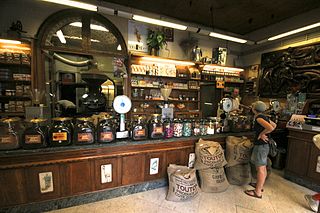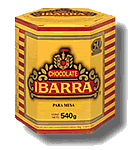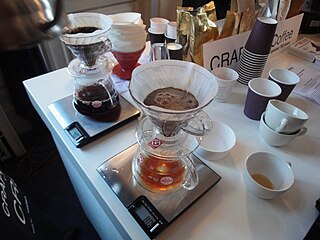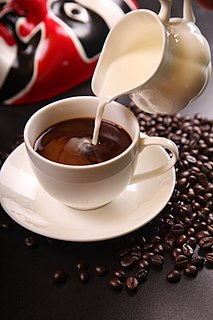
A drink is a liquid intended for human consumption. In addition to their basic function of satisfying thirst, drinks play important roles in human culture. Common types of drinks include plain drinking water, milk, juice, smoothies and soft drinks. Traditionally warm beverages include coffee, tea, and hot chocolate. Caffeinated drinks that contain the stimulant caffeine have a long history.

A cappuccino is an espresso-based coffee drink that originated in Italy and is prepared with steamed milk foam (microfoam).

Espresso is a coffee-brewing method of Italian origin, in which a small amount of nearly boiling water is forced under 9–10 bars of pressure through finely-ground coffee beans. Espresso coffee can be made with a wide variety of coffee beans and roast degrees. Espresso is the most common way of making coffee in southern Europe, especially in Italy, France, Spain, and Portugal. It is also popular in Switzerland, Croatia, Bulgaria, Greece, and in Australia.

Italians are well known for their special attention to the preparation, the selection of the blends, and the use of accessories when creating many types of coffees. Many of the types of coffee preparation known today also have their roots here. The main coffee port in Italy is Trieste where there is also a lot of coffee processing industry. Italian coffee consumption, often espresso, is highest in the city of Trieste, with an average of 1500 cups of coffee per person per year. That is about twice as much as is usually drunk in Italy.

Caffè latte, often shortened to just latte in English, is a coffee beverage of Italian origin made with espresso and steamed milk. Variants include the chocolate-flavored mocha or replacing the coffee with another beverage base such as masala chai, mate, matcha, turmeric, or rooibos; alternatives to milk, such as soy milk or almond milk, are also used.

Hot chocolate, also known as hot cocoa or drinking chocolate, is heated chocolate milk. Hot chocolate made with melted chocolate is sometimes called drinking chocolate, characterized by less sweetness and a thicker consistency.

Ristretto is a "short shot" of a more highly concentrated espresso coffee. It is made with the same amount of ground coffee, but extracted with a finer grind using half as much water. A normal short shot might look like a ristretto, but in reality, would only be a weaker, more diluted, shot. The opposite of a ristretto is a lungo ("long"), which is a double shot. The French call a ristretto a café serré.

Eggnog, historically also known as a milk punch or an egg milk punch when alcoholic beverages are added, is a rich, chilled, sweetened, dairy-based beverage. It is traditionally made with milk, cream, sugar, egg yolks, and whipped egg whites. Distilled spirits such as brandy, rum, whisky or bourbon are often a key ingredient.

Milo is a chocolate-flavoured malted powder product produced by Nestlé, typically mixed with milk, hot water, or both, to produce a beverage. It was originally developed in Australia by Thomas Mayne in 1934.

Teh talua or egg tea is a tea beverage from West Sumatra, Indonesia. The tea is unique because of the use of egg yolk in its preparation. Chicken or duck egg can be chosen for the tea. Other ingredients, in addition to tea and egg yolk, are sugar and calamondin.

Abuelita is a chocolate tablet, syrup, or powdered mix in individual packets, made by Nestlé and used to make Mexican-style hot chocolate, also known as chocolate para mesa. It was originally invented and commercialized in Mexico in 1939, by Fábrica de Chocolates La Azteca. The name is an affectionate Spanish word for "grandma". Since 1973, Mexican actress Sara García has been the image for the brand before the Swiss company acquired it in the 1990s.

A caffè mocha, also called mocaccino, is a chocolate-flavoured warm beverage that is a variant of a caffè latte, commonly served in a glass rather than a mug. Other commonly used spellings are mochaccino and also mochachino. The name is derived from the city of Mocha, Yemen, which was one of the centres of early coffee trade. Like latte, the name is commonly shortened to just mocha.

Ibarra is a brand of Mexican chocolate para mesa, produced since 1925, and since 1954 produced by the company Chocolatera de Jalisco of Guadalajara, Jalisco, Mexico. The company manufactures other chocolate products, but Ibarra table chocolate is its best-known product, with presence throughout Mexico as well as international markets, mainly in the Americas, but also in parts of Europe. It is often found in gourmet shops.

Coffee preparation is the process of turning coffee beans into a beverage. While the particular steps vary with the type of coffee and with the raw materials, the process includes four basic steps: raw coffee beans must be roasted, the roasted coffee beans must then be ground, and the ground coffee must then be mixed with hot or cold water for a specific time (brewed), the liquid coffee extraction must be separated from the used grounds, and finally, if desired, the extracted coffee is combined with other elements of the desired beverage, such as sweeteners, dairy products, dairy alternatives, or toppings.
Coffee cupping, or coffee tasting, is the practice of observing the tastes and aromas of brewed coffee. It is a professional practice but can be done informally by anyone or by professionals known as "Q Graders". A standard coffee cupping procedure involves deeply sniffing the coffee, then slurping the coffee from a spoon so it is aerated and spread across the tongue. The coffee taster attempts to measure aspects of the coffee's taste, specifically the body, sweetness, acidity, flavour, and aftertaste. Since coffee beans embody telltale flavours from the region where they were grown, cuppers may attempt to identify the coffee's origin.

Milk coffee is a category of coffee-based drinks made with milk. Johan Nieuhof, the Dutch ambassador to China, is credited as the first person to drink coffee with milk when he experimented with it around 1660.

An affogato /ˌɑːfəˈɡɑːtəʊ/, /ˌæfəˈɡɑːtəʊ/ or more traditionally known as "affogato al caffe" is an Italian coffee-based dessert. It usually takes the form of a scoop of plain milk-flavored or vanilla gelato or ice cream topped or "drowned" with a shot of hot espresso. Some variations also include a shot of amaretto, Bicerin, Kahlua, or other liqueur.

A frappé coffee, Greek frappé, Nescafé frappé, or just frappé is a Greek iced coffee drink made from instant coffee, water, sugar, and milk. The word is often written frappe. The frappé was invented through experimentation by Dimitris Vakondios, a Nescafe representative, in 1957 in Thessaloniki. Frappés are among the most popular forms of coffee in Greece and Cyprus and have become a hallmark of postwar outdoor Greek coffee culture.




















